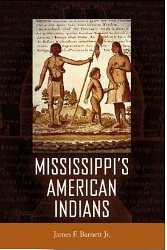Having recently transitioned into a new job that includes oversight of Indian mound sites, I decided to read Mississippi’s American Indians by James Barnett Jr. I had no doubt that Barnett, longtime director of Historic Properties in Mississippi and renowned expert of the Natchez Indians, would craft a book that would provide a nice overview of Mississippi’s Native Americans. And miraculously Barnett did just that, covering thousands of years of Indian history in a little over two hundred pages.
Barnett divides his book into six chapters plus an epilogue. His first chapter covers thousands of years of prehistory. In 33 pages, Barnett covers all the major eras from the Early Paleoindian Period (10,000 B.C.) to the Mississippian Period (1200-1700 AD). Of course, we must rely on the exceptional work of archaeologists to learn about prehistory without any written word, and thankfully, we have learned quite a lot. Unfortunately, like in other studies of prehistoric Indians, what we have learned comes across without any real narrative. We know basic information such as methods of obtaining food and the type of containers such food was prepared and stored, but anyone looking for a captivating story is always left disappointed. No matter how well any prehistory is written, it comes across like any other archaeology report, a bit too scientific and dry for my taste with too many pages discussing pottery sherds and hunter/gatherer societies.
In later chapters, the story picks up momentum as the tragic story of interaction with Europeans unfolds. Barnett expertly crafts events such as De Soto’s invasion and the conflicts between the French and the Natchez Indians. I especially enjoyed the discussions concerning the Choctaw and Chickasaw Indians and their conflicts and attempts to play the French and English off one another in their efforts to acquire supplies and maintain control over their territories. Of course, Barnett’s story has to end with the removal period where the nations were forced off their lands and moved westward. The general public usually identifies the Cherokees with the Trail of Tears, but Barnett provides a narrative that shows the Choctaw and Chickasaw suffered greatly as well during their westward journey due to either incompetence or corruption.
Barnett is to be commended for drafting this solid overview, but I wonder if this type of overview just doesn’t work. There is simply too much information and history to weave into one single narrative. For one who likes his history to contain a story, this overview can’t achieve the impossible and mainly serves as a textbook. I am happy to have read this book and will keep it handy as a reference on Mississippi’s indigenous cultures, but it won’t be one I read over and over again.
CPW

